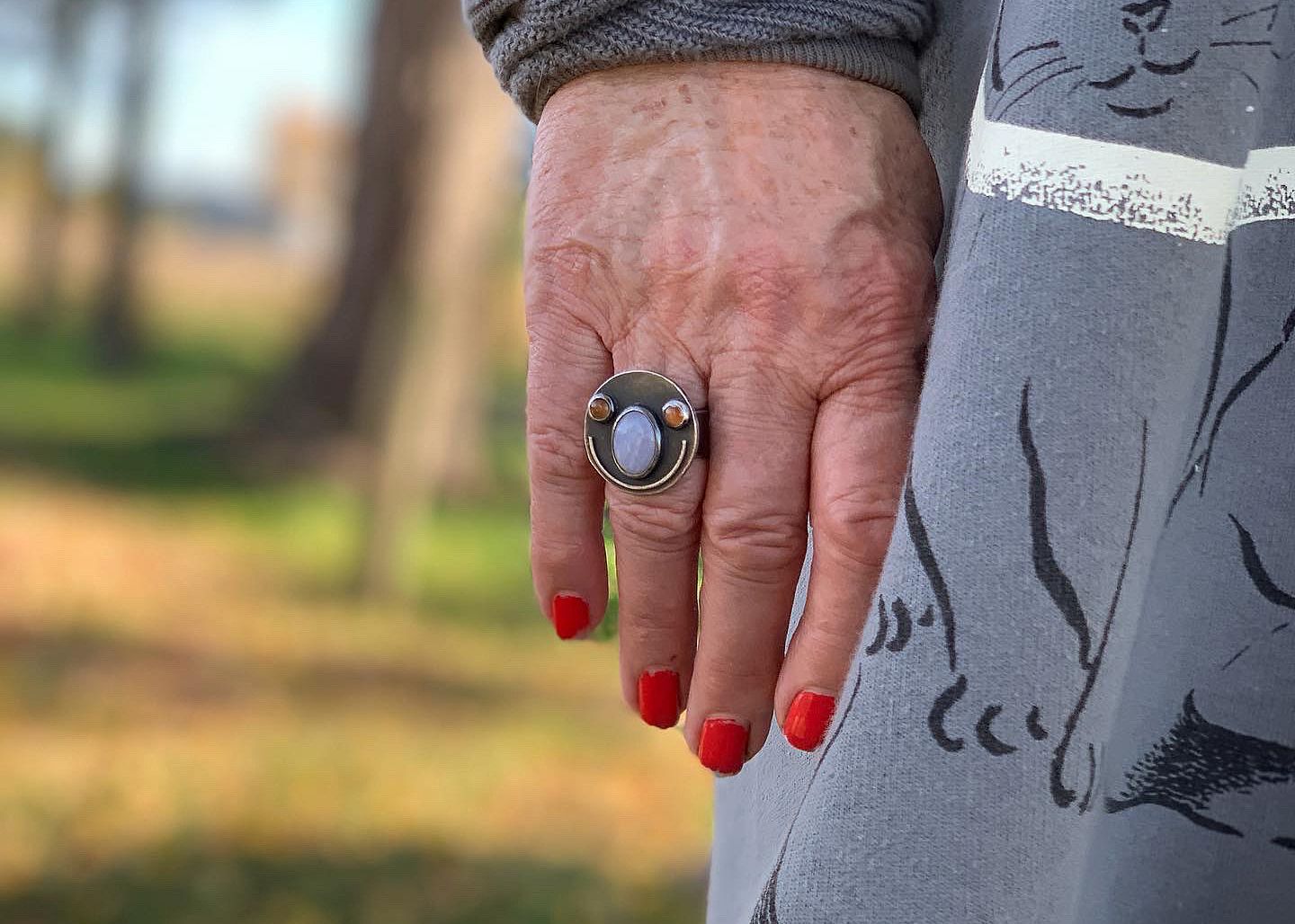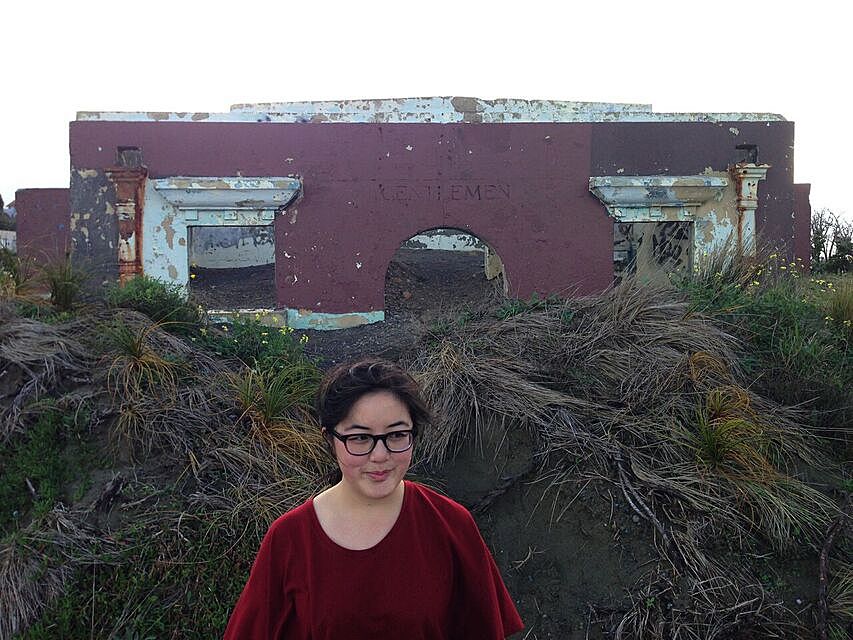Art’s Afterlives: Jewellery at Home
The National’s ‘What I’m Wearing’ Instagram series reveals the intimate way that contemporary jewellery develops meaning long after leaving the gallery.
Our encounters with most art objects are fleeting, lasting seconds or minutes at best, during exhibitions visited only once. Art is always slipping from view, exiting galleries and passing into private domains. Some will weave back into the public eye, perhaps at auction or at a museum, but most does not.
What of the art that remains out of view? Lately, Instagram has been threaded with glimpses of its afterlives. Nimble galleries, deprived of the usual venues for encounter, have embraced the context of lockdown, peeking in on artists and their allies at home.
The rearrangement of public and private realms has been one of this pandemic’s most immediate consequences. A sudden vulnerability has accompanied it, as our bubbles magnified the details of our domestic circumstances. The stream of ‘at home’ posts has been gentle and nourishing; a reminder that art objects are things that people love and live with, as well as being academic and financial objects. But at other times – when children, flatmates and unmade beds stray into frame during work calls – it feels more like lockdown has chain-sawed a hole through the wall that previously guarded our private lives.
A week into the lockdown, an Instagram post by The National – a jewellery gallery in Ōtautahi Christchurch – celebrated the collision of these domestic conditions. Hands on hips, gallerist Anna Miles supervises her sons as they tidy their bedroom – with a yellow parekareka (spotted shag) foot pendant by jeweller Jane Dodd flashing against her black turtleneck. “The claws may come in very handy in the next few weeks,” wrote Anna in her caption. Alongside the images, she narrated the significance of the pendant, not only as a token wielded in parental duties, but also as an object that knots together moments in her life – both formative and trying – and the people with whom they are shared.
The post was the first in a series. As we persevered through Alert Levels 4 and 3, Caroline Billing, The National’s director, continued to ask individuals what jewellery they’ve been wearing during confinement – which she calls “the essential non-essential question”.
The ‘jewels’ that feature in the series are exuberant in their use of subversive materials. Rubber tubes that have been carefully wriggled off paperclips, paua, carved wood and recycled takeaway containers are just some of the materials that have been used to compose them. This is the world of contemporary jewellery; a self-reflexive practice that sees makers push the limits of our tastes and expectations as they explore the history of jewellery and adornment, its materials and forms, and its relationship to the body.
At home with her toddler while her husband continued as an essential worker, Caroline was, like the rest of us, negotiating a rapidly shifting definition of what (and who) might be considered ‘essential’. Recognising the apparent absurdity of her question – there are people wearing jewellery during lockdown?? – Caroline’s series plays with the freewheeling contingency of essential-ness.
Jewellery may not be essential for sustaining life but it has long been a form of sustaining meaning across lives
Lockdown has been framed as a period of survival, of saving lives. Jewellery may not be essential for sustaining life but it has long been a form of sustaining meaning across lives – with others within a lifetime or between generations. In Aotearoa, these relational functions are evident in the rich and evolving practices of Moana adornment: ranging from the gifting of pounamu to the making of garlands, and the reinvention of adornment traditions by Māori and Pacific artists to make contemporary political statements. Adornment is an ancient form of making, expressing and sharing meaning. It may not fulfil the fundamentals of Maslow’s hierarchy of needs, but it helps us reach his pyramid’s pinnacle – an ascent through belonging, esteem and self-actualisation.
For makers, collectors and admirers of jewellery, these are essential functions. But sadly, appreciation for the full breadth of jewellery’s social roles – its potential for winking humour, critique and the binding of relationships – is patchy. Heirloom practices persist, but the popular view of jewellery’s value revolves around precious metals and stones, with their hard glint of accumulated cachet and currency. As a consequence, jewellery is often passed over as an ornamental practice of excess, surplus to human requirements.
In The National’s series on Instagram, the personal nature of making meaning through jewellery comes to the fore. The accompanying captions often describe this ongoing process of developing meaning through wearing: the way that Garth O’Brien groups his brooches into unique configurations of makers, symbols and materials; the way that Philip Clarke carries his connection to Rangitoto with him when he wears his Warwick Freeman Star Heart; or the way that Karin Johansson’s carnelian bracelets remind her of the gestures of human connection her hands usually enact.
Some writers reflect on their experiences of lockdown itself through their relationships to their jewels – a kind of thinking through jewellery. Art historian Liesbeth den Besten hadn’t been wearing hers because, for her, “jewellery needs to shine, needs to be seen, jewellery is about socialising”. For documentary heritage specialist Jane Wild, her usual pieces enjoyed “a deserved rest”. Instead the confines of home allowed delicate works like Manon van Kouswijk’s Paper Pearls to shine. Artist Audrey Baldwin wore a road-cone earring – an “in-joke” for those who lived through post-quake Christchurch’s “cone-o-rama”, and a reminder of bumpy times previously overcome.
The people featured in The National’s series include local – and a few international – jewellers and champions of contemporary jewellery, collectors, and gallerists. There’s even a wildcard appearance from Aotearoa’s foremost front-facing camera comedian, Thomas Sainsbury, covering off the costume jewellery spectrum with pieces from Look Sharp, Lovisa and Farmers.
The series could be considered a kind of dispersed, online exhibition, but it is in some ways an inverse to conventional exhibitions: where galleries and museums are burdened by the illusion of acontextual objectivity, this series is framed by personalised contexts of home; where exhibitions amplify the call of artists and curators, this series calls back with the aroha of these collectors for their jewels and their makers.
Caroline tells me that the feedback from contributors to the series has been rewarding. Sharing how happy it made them to take part, many have thanked her for the opportunity. The series creates space for reciprocity, allowing individuals to share the way these jewels continue to make meaning in their lives. Caroline says, “I like to think that for the artist of a work, reading a response from a wearer in this way would be so satisfying. A kind of giving back in the artistic process, but from the collectors.”
Our focus is often on artists as authors of meaning, but this series shifts our attention to the ongoing relationship between art objects and the people who collect, receive and look after them.
Jeweller Areta Wilkinson took the opportunity to show something she doesn’t usually wear – an enormous glazed ceramic tiki made in 1967 by Sally Vincent, a Swiss immigrant to Kaitaia. Bought from Vincent by her grandparents, the tiki passed to Wilkinson after the death of her uncle. For Wilkinson, the tiki is embedded with the friendship between her Māori grandparents and Sally Vincent and her husband, as well as fondly remembered aspects of Northland’s community life during her childhood and teenage years.
When our lives are unsettled, it is grounding to be reminded of our taonga tuku iho, and the meaning that endures
The passing of heirlooms from generation to generation is a practice shared across many, if not all, cultures, with the shared objects embodying connection, whakapapa and the memories of lives lived. At times such as these, when our lives are unsettled and things that once seemed certain prove to be fleeting, it is grounding to be reminded of our taonga tuku iho, and the meaning that endures and will survive us.
Given all this talk of relationships and being knotted together through objects, it seems fitting that The National’s Instagram series began with a thoughtful message that Caroline received from Anna Miles. It was the picture of Anna wearing the parekareka pendant. Knowing that a pendant from the same series was included in Caroline’s latest exhibition (originally intended for a cancelled showing in Munich), Anna texted Caroline to say that she was wearing hers to oversee the boys tidying their room.
“I think this was the first collegial contact I had had [during lockdown],” says Caroline. “I was home alone with my 2-year-old for eight days straight as Level 4 hit (my husband’s an essential worker). Anna sent me a longer story to post, with a picture of the latest Parekareka. And suddenly, an idea was born. Selfies from people at home with their jewellery! Stories and selfies, of people at home with their jewellery. I suddenly wondered what jewellery they might be choosing as important to them, or to wear, during this time of isolation.”
It’s a story that arcs through the rapid changes of the past two months – the swish exhibition originally intended for Munich, quickly retitled At Home and adapted for a local showing as the pandemic encroached, to the closure of Caroline’s gallery and the reframing of one of Jane Dodd’s Parekareka pendants within the humdrum domesticity of a bedroom being tidied. Parekareka would have made meaning in each of these contexts, but in its eventual one it has resonated deeply with many who have seen the post while at home themselves.
The National’s physical gallery is open again. Caroline hasn’t yet decided whether to continue the series on Instagram beyond lockdown, though she says she’s sure these stories will continue to be shared.
In the grander scheme of things, I think we’ll see, in the coming weeks, months and years, whether our public and private lives resettle into their old arrangements, or whether the kindnesses and violations of the lockdown period have lasting impacts. What endures?
Feature image: Sue Billing wears a ring by Frances Stachl. Photo by Caroline Billing.
This piece is presented as part of a partnership with Blumhardt Foundation. They cover the costs of paying our writers while we retain all editorial control.


